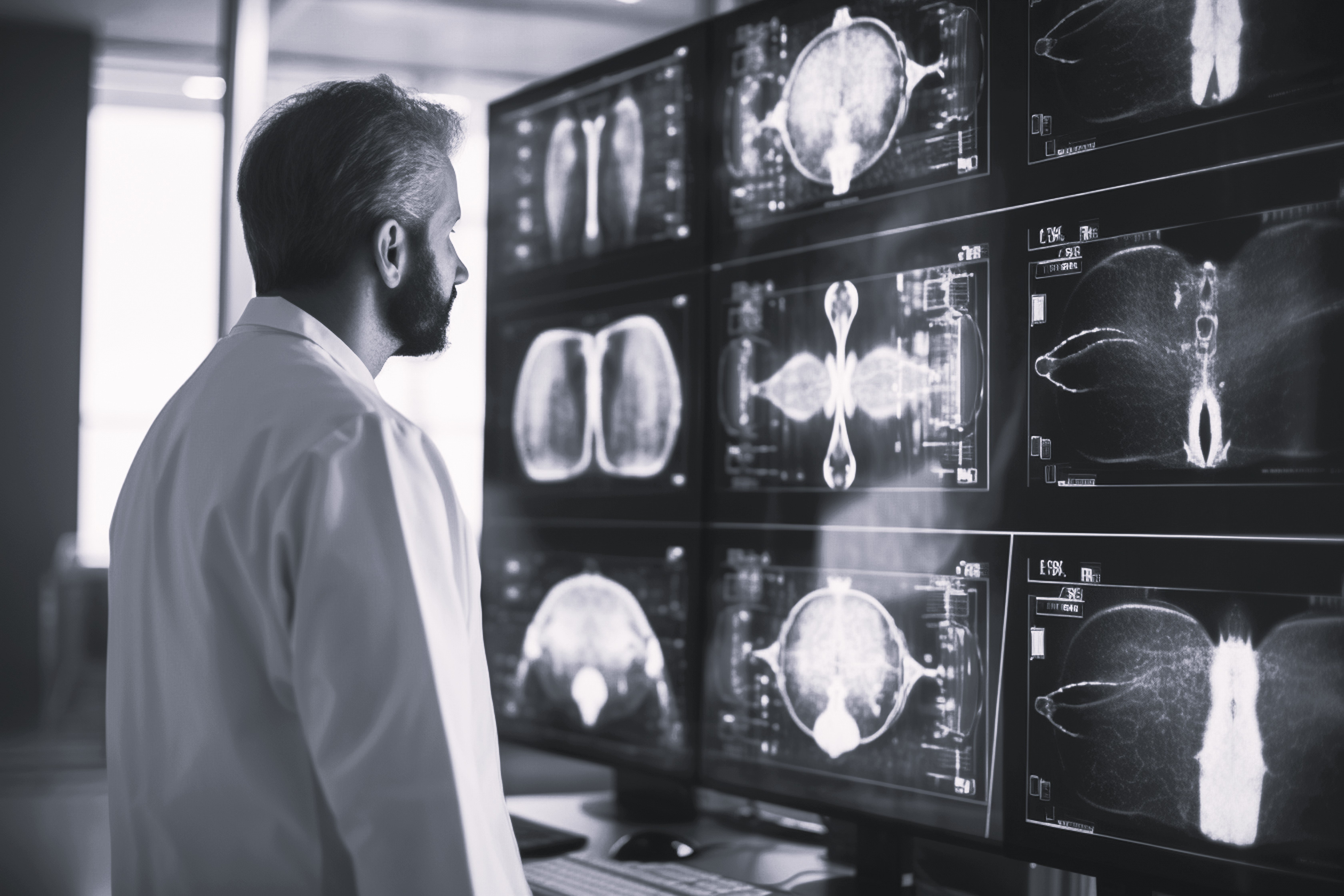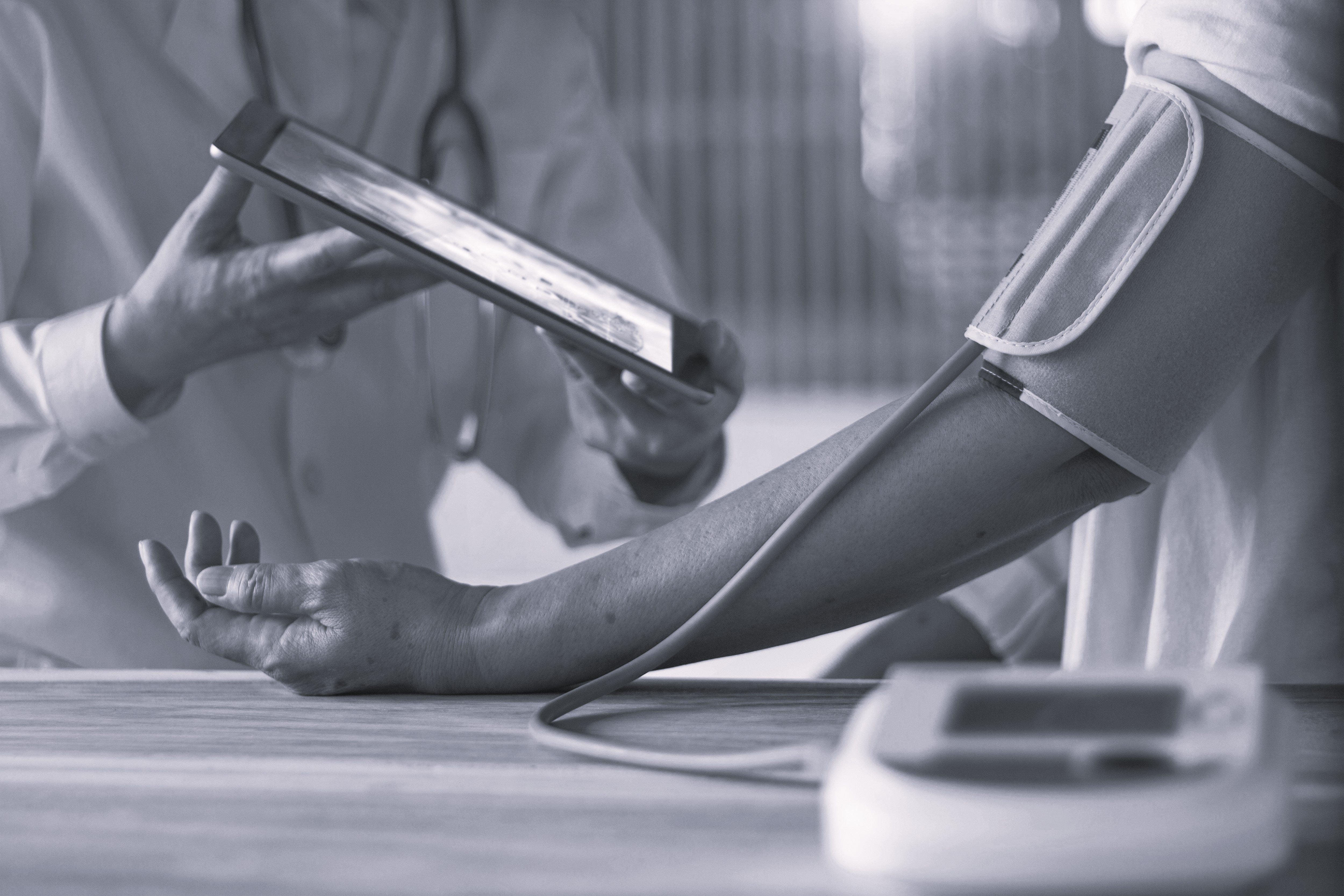The future is smart: IoT, AI, and Big Data - Smart City & Smart Campus
How public administrations and educational institutions can benefit from these technologies The transformative role of IoT, AI, and Big Data in the...
10 min read
 Géraldine Wymann
:
May 16, 2024 10:27:39 AM
Géraldine Wymann
:
May 16, 2024 10:27:39 AM

The integration of wireless technology within the Internet of Things (IoT), the adoption of telemedicine, the incorporation of artificial intelligence (AI), and the emphasis on interoperability in healthcare are poised to revolutionize the provision of medical services. These trends are increasingly recognized for their advantages, including enhanced patient care, improved diagnostic precision, and streamlined data sharing. In this blog, we will explore these four pivotal trends for the year 2024, engaging in discussions with industry experts to gain deeper insights.

The integration of the Internet of Things (IoT) into healthcare holds immense potential to improve the quality of patient care, optimize process efficiency, and reduce healthcare costs. However, while the benefits are evident, there are also challenges to address.
The use of IoT in healthcare enables effective monitoring and management of medical devices, real-time tracking of patient data, and process automation. Wearable devices, smart sensors, and health trackers provide precise data that assists doctors and nursing staff in diagnosis and treatment decisions. Hospitals can achieve more efficient workflows, better resource management, and personalized patient care with IoT solutions.
Despite the promising opportunities, there are challenges to overcome. The costs of IoT devices, infrastructure, and implementation can be barriers, especially for small healthcare facilities. Compatibility with existing systems and the integration of various IoT devices require technical expertise and careful planning. Additionally, privacy and security concerns are significant, as medical data is sensitive and requires a high level of protection.
To successfully shape the future of IoT in healthcare, a holistic approach is required. Technological innovations must be accompanied by cost-effective solutions that ensure accessibility, interoperability, and scalability. Decision-makers need to make strategic investments in building IoT infrastructure and training professionals to fully leverage the benefits of IoT. Regulatory frameworks must be flexible and ensure the privacy and security of patient data.
"As part of a current project, we monitor and log the temperature of the rooms where medications are stored using IoT devices. Thanks to IoT and LoRa technologies, we don't need additional infrastructure and can perform the analysis and monitoring directly through the manufacturer's cloud application."
Simon Bürgy, Leiter Informatik at PZM Psychiatriezentrum Münsingen AG
"Despite the security challenges associated with IoT technology, it has the potential to transform the patient experience and revolutionize tomorrow’s smart hospitals. Healthcare organizations must take a multi-layered approach to mitigate security risks using IEC 80001 as a framework. Knowledgeable IT staff, full network visibility, along with behavior analysis, ML/AI, and analytical tools, will provide a better pathway to ensure strong IoT security across all connected devices.
Not only will stronger security measures result in cost savings for hospitals long term – fewer data breaches mean less repair of damages – but most importantly, it will mitigate the life-threatening implications of insecure IoT technology. Patients' lives depend on secure connected devices, so healthcare organizations must act."
Michael Schwanke-Seer, Senior Key Account Manager Healthcare at Extreme Networks
Telemedicine has become an integral aspect of Switzerland's healthcare landscape, forming part of the broader eHealth initiative. It facilitates digital consultations between healthcare providers and patients, reducing the need for in-person visits. Since the inception of netCare pharmacies in 2015, their numbers have steadily increased, reaching a peak of 371 pharmacies by 2019.
Telemedicine offers numerous advantages, including enhanced medical care accessibility in remote regions, cost and time savings for patients, and the ability to remotely monitor patient health metrics. Through the use of video conferencing platforms and IoT devices, effective communication between healthcare professionals and patients is ensured, along with continuous monitoring of vital signs.
However, the success of telemedicine in Switzerland hinges upon overcoming certain challenges, such as ensuring data privacy and security and addressing regulatory complexities. Establishing clear guidelines and standards for safeguarding sensitive medical information, as well as developing a robust legal framework, are imperative to foster patient trust and confidence in telemedicine practices.
Nevertheless, telemedicine presents a promising avenue for advancing healthcare delivery in Switzerland. It contributes to efficiency improvements, mitigates waiting times, and enhances overall healthcare accessibility. By further refining and thoughtfully implementing telemedicine solutions, Switzerland can capitalize on its benefits, ensuring a forward-looking and responsive healthcare system for its populace.
"IT staffing shortages is a top organizational challenge in the Healthcare space.
The lack of a skilled, capable IT teams makes it harder for clinicians to do their jobs, leading to staff burnout and poor patient outcomes.
And, of course, without a strong IT team, it’s more difficult for hospitals to put systems in place that are needed to support modern care delivery and to improve patient outcomes and experience, such as telemedicine applications.
A lot of organizations therefore focus on new applications, cybersecurity efforts or the patient experience and lose sight that their network infrastructure is the core that makes all of those applications succeed."
Doug McDonald, Director of Extreme Alliances in the Office of the Chief Technology Officer at Extreme Networks
The integration of artificial intelligence (AI) into healthcare has witnessed significant growth in recent years, a trend that is poised to continue in 2024. Particularly in the field of medicine, AI is being leveraged for diagnostics and disease identification.
AI algorithms have the capacity to swiftly and accurately analyze CT scans from thousands of patients, detecting pneumonia patterns associated with COVID-19 and promptly notifying clinical physicians. This capability helps alleviate the scarcity of qualified professionals in this domain.
Innovative initiatives like Imaging COVID-19, founded on deep learning principles, already exist, automatically identifying COVID-19 patterns in CT scans.
In forward-thinking medical facilities, AI serves as an adjunctive tool rather than a standalone diagnostic or therapeutic modality. AI aids in confirming existing diagnoses and supplementing conventional data collection in medical research. The amalgamation of AI technology and human expertise promises optimized patient care and enhanced medical diagnostics.
The pharmaceutical industry is harnessing artificial intelligence (AI) to unearth novel medications and capitalize on prevailing medical technological trends.
AI-enhanced laboratory experiments have led to the discovery of further promising formulas for potential remedies targeting rare and perilous diseases. AI and machine learning techniques are applied in chemical experiments and drug development processes, including molecule modeling and simulating chemical reactions under multifactorial conditions.
These methodologies empower researchers to minimize costly on-site experiments involving reagents and state-of-the-art laboratory equipment, as many experiments can be conducted virtually. This expedites the discovery of foundational scientific breakthroughs.
The objective of robot-assisted systems is to curtail costs associated with qualified hospital staff and alleviate the acute shortage of caregivers and physicians. The aim is for AI-driven and robotic systems to complement traditional medical practices rather than supplant them.
In the implementation of these technological advancements, it is imperative to heed the limitations and apprehensions of the medical community regarding AI-driven software. There exists substantial potential for the deployment of robots and automated systems in contemporary medicine, encompassing domains such as hygiene, surgery, and remote monitoring. Striking an optimal balance between audacious initiatives and prudent regulation is paramount to leveraging the benefits of these technologies while mitigating potential risks.
Chatbots, AI-based computer applications engaging in human-like conversations through speech, text, or predefined options, are gaining traction across various industries, including healthcare. Chatbots facilitate preliminary diagnosis and dispense health advice to patients. They are accessible online or via mobile devices around the clock and can be seamlessly integrated into customized patient portals for hospitals and clinics.
A notable challenge in deploying chatbots lies in ensuring the provision of accurate information and recommendations, thereby mitigating the risk of misinformation and erroneous self-diagnoses. Hence, a cautious approach is warranted.
"At the moment, Artificial Intelligence is not a topic for us. We do not use any software or solutions. In my opinion, the topic is still too new and not sufficiently advanced to implement proven solutions directly without building internal expertise. Data protection is our top priority, as we process highly sensitive personal data and must handle it extremely carefully."
Simon Bürgy, Leiter Informatik at PZM Psychiatriezentrum Münsingen AG
"The advancements in computer technology now allow for astonishing achievements with AI. Many individuals readily accept this support for our work. However, as system administrators, you must also consider where and how the data is processed and whether it aligns with data protection and patient rights. A structured supplier management helps you identify these risks and not only select the best service but also find a trustworthy provider. This way, you can assure your patients that their sensitive data is in good hands with you."
Martin Buck, CISO & Head of Consulting Services at BNC

Based on a survey conducted by the University of Zurich and GFS Bern within the Digital Society Initiative (DSI), approximately two-thirds of the Swiss population express a positive attitude towards the integration of digital twins into healthcare services. This representative study, encompassing nearly 1500 respondents, reveals that 62% of participants endorse the utilization of digital twins. Notably, there is a noteworthy acceptance of digital twins among older demographics.
The survey results also suggest that the majority of individuals believe that only medical professionals should utilize digital twins for diagnosis and therapy. Additionally, many support the notion that there should be no compulsion to use digital twins, even if it might impact the treatment for the individuals involved.
In terms of data privacy, there are mixed opinions. While 64% of respondents support the anonymous sharing of data for the development of digital twins, many are skeptical when it comes to sharing data with private companies. There is a high level of distrust towards the pharmaceutical industry, tech companies, and health insurance companies, while trust in universities, public hospitals, and federal offices regarding the responsible use of digital twins is higher.
The results also indicate that people expect the government to establish the technical and organizational requirements for the use of digital twins. Trust in public entities is high, while trust in private companies is lower.
The use of digital twins in healthcare has the potential to enhance diagnosis and therapy, but also presents challenges regarding data privacy and patient trust. The survey results provide valuable insights into the opinions and attitudes of the Swiss population on this topic, highlighting the importance of responsible use of digital twins in healthcare.
Promoting interoperability within the Swiss healthcare sector is a significant trend that facilitates a comprehensive transformation of healthcare delivery. Switzerland is actively pursuing various initiatives and projects, such as e-Health Suisse, the electronic patient record (EPR) system, and the Swiss Personalized Health Network, aimed at enhancing the exchange of health data and fostering collaboration among medical institutions.
These initiatives seek to eradicate data silos and enable seamless information sharing across diverse healthcare systems. This involves establishing standardized protocols and common standards to ensure a unified data structure and terminology. Through the implementation of interoperable IT systems, data can be processed and exchanged uniformly, irrespective of the specific technologies employed by individual institutions.
Achieving successful interoperability requires close cooperation and coordination among stakeholders within the healthcare sector. This necessitates a comprehensive approach involving governmental bodies, hospitals, healthcare professionals, pharmacies, research institutions, and other pertinent partners. Additionally, ensuring data privacy and security is paramount to safeguarding the confidentiality and integrity of health information.
"The seamless exchange of health information can simplify and expedite many processes and promote comprehensive patient care. Additionally, it offers great potential for research as the available database grows. Standardizing exchange formats aids in Swiss and international collaboration. However, this does not exempt you from the responsibility of ensuring the security of exchanged data. Topics such as encryption, complete anonymization, or appropriate access controls are important parts of your project that must be considered before implementation. Otherwise, high penalties and reputational damage may occur if these sensitive data fall into the wrong hands."
Martin Buck, CISO & Head of Consulting Services at BNC
In summary, the integration of wireless technology in the Internet of Things (IoT), the adoption of telemedicine, the implementation of artificial intelligence (AI), and the promotion of interoperability in healthcare have the potential to profoundly reshape the delivery of medical services. By enabling continuous monitoring of vital signs, facilitating virtual consultations with healthcare providers, enhancing diagnostic capabilities through AI, and ensuring seamless data exchange among medical facilities, these advancements offer new avenues for improving patient care and streamlining healthcare operations.
With the growing prevalence of IoT devices and interconnected medical equipment in healthcare settings, it is imperative that hospital Wi-Fi infrastructures evolve to accommodate the increasing number of connected devices. Insufficient coverage or unreliable connections could pose significant challenges, impacting the transmission of medical data and hindering effective communication between administrative systems.
As highlighted by Martin Niemann, Sales Director Zurich at BNC AG:
"The rapid technological change combined with an increasing expectation for cost-effective medical treatments is just beginning and will continue to intensify. The trends in healthcare are highly discernible. Without the adoption of advanced technologies, whether through IoT devices or robust automation combined with AI solutions, expectations cannot be met. Flexibility, technical openness to new solutions, and simultaneously enhancing security are becoming challenging issues for all network and security professionals in healthcare. Local boundaries will continue to diminish in significance, allowing treatments and medical services to be provided between healthcare facilities and patients regionally and even internationally. To ensure this, strong and trustworthy partnerships between healthcare providers, patients, and technology providers are needed. We are confident that we can contribute as a technology partner."
The Wi-Fi infrastructures in hospitals must be scalable and reliable to meet the demands of connected devices. This ensures not only optimal patient care and efficient use of medical devices but also smooth administrative processes. Through regular updates and close collaboration with manufacturers, network administrators can ensure that the Wi-Fi network meets the growing demands and maintains a stable network connection.
Wi-Fi 7 enables ultra-fast data transfer rates, supporting smooth communication and real-time transmission of medical data. This speeds up the treatment process and enhances patient care.
With the increasing number of wireless devices and applications in healthcare, Wi-Fi 7 provides greater network capacity to handle increased data traffic and ensure reliable connectivity for a variety of devices.
The enhanced efficiency of Wi-Fi 7 reduces latency and ensures a reliable connection. This enables real-time monitoring, telemedicine, and the use of medical robots or augmented reality in surgery without interruptions or delays.
Wi-Fi 7 can further advance healthcare in terms of the Internet of Things (IoT) and Artificial Intelligence (AI). The increased capacity and efficiency allow seamless integration of medical devices and processing of large datasets for advanced analysis and diagnosis.
The implementation of Wi-Fi 7 may require investments in network infrastructure to support higher bandwidths and capacities. Hospitals need to carefully weigh the costs and practical aspects of upgrading their Wi-Fi systems.
Integrating Wi-Fi 7 into existing IT systems and medical devices can be challenging. Seamless communication and interoperability between different systems and devices should be ensured.
With increased networking and exchange of sensitive medical data, security becomes paramount. Wi-Fi 7 needs to be equipped with robust security protocols and encryption methods to prevent data loss or unauthorized access.
Healthcare staff needs to have the necessary knowledge and skills to effectively use and manage Wi-Fi 7. Training and education are required to ensure that staff can fully utilize the new features and capabilities of Wi-Fi 7.
https://www.rfpage.com/how-wireless-technology-used-medicine-healthcare/
https://www.ncbi.nlm.nih.gov/pmc/articles/PMC8717044/
https://www.mdpi.com/1424-8220/22/16/6209
https://tateeda.com/blog/healthcare-technology-trends
https://de.statista.com/themen/3328/ehealth-in-der-schweiz/#topicOverview
https://dizh.ch/2023/09/26/kuenstliche-intelligenz-in-der-medizin/

How public administrations and educational institutions can benefit from these technologies The transformative role of IoT, AI, and Big Data in the...

The future of connectivity An analysis of the significance of 5G, Wi-Fi 6E, Wi-Fi 7, IoT, and AI for IT service providers in Switzerland

What awaits the Head of IT in Banks and Insurance Companies in the year 2024? IoT, Telematics, Usage-Based Insurance, Open Banking, and Big Data...